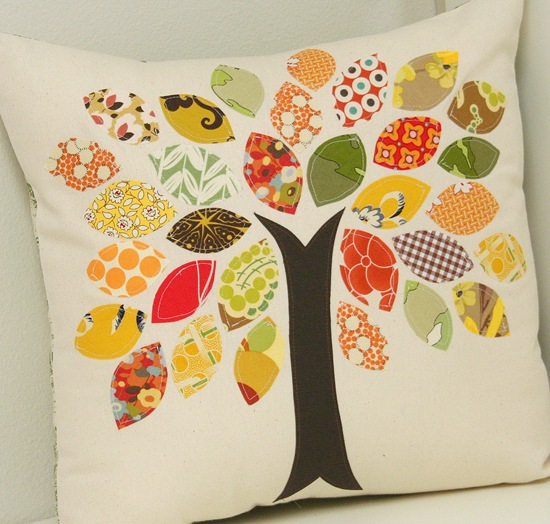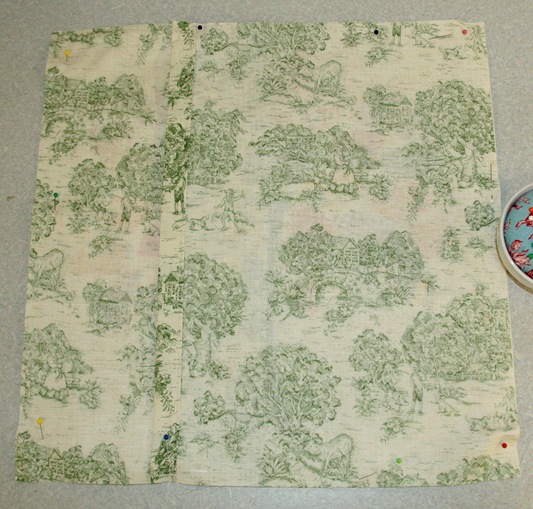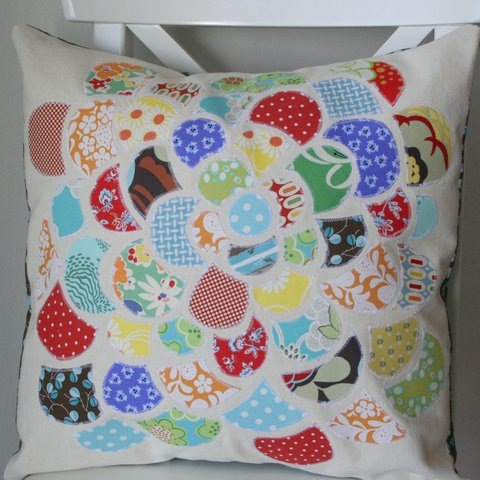
Aqui tem um tutorial para fazer essa almofada linda!!!! Bem prática e com um toque bem interessante... Fonte: http://www.cluckclucksew.com/2009/10/tutorial-scrap-buster-fall-pillow.html
This is my favorite thing to do with my little scraps, and since its Scrap Buster month over at Sew, Mama, Sew,
I made a quick tutorial so you can make your own. This pillow cover is
16" square with an envelope back & the design possibilities are
endless! I added some pillows I’ve previously made with this same
method at the end of this post. Happy Sewing!
You’ll Need: 1.
Scraps, enough for the tree trunk and the leaves. Cutting your scraps
into rectangles will make it easier to adhere them to the appliqué
material.
1.
Scraps, enough for the tree trunk and the leaves. Cutting your scraps
into rectangles will make it easier to adhere them to the appliqué
material.
 1.
Scraps, enough for the tree trunk and the leaves. Cutting your scraps
into rectangles will make it easier to adhere them to the appliqué
material.
1.
Scraps, enough for the tree trunk and the leaves. Cutting your scraps
into rectangles will make it easier to adhere them to the appliqué
material.
2. Appliqué material: I use Heat' n Bond. You’ll need about 1/2 yard or more depending on how many leaves you want to make.
3.
Material for the pillow front, cut to 17" x 17" square. I used
lightweight canvas and prefer home weight material, but you could use
anything.
4. Material for the back. Cut 1 rectangle 17"x 14" and cut 1 rectangle 17"x 10".
Iron
your fabric scraps onto your appliqué material according to the
directions on the appliqué material. (press & hold the iron over
each scrap for a few seconds, I use a very hot iron and find the
appliqué material sticks better)
Now
with scissors cut out your trunk and leaf shapes. For the trunk I
first draw the shape of the trunk on the back of the appliqué material
so I get a nice shape, but for the leaves I just free cut as I go. And
for reference the trunk on mine is 8" tall, and my leaves are all about
2.5" long and are 1.5" or so wide.
When you
get all your leaves cut out, tear the backing appliqué paper off the
leaves and trunk. I prefer to do this while plopped down in front of
the TV cause it takes awhile. :) Or better yet enlist some help.
Then you can arrange them how you want on your pillow front. Don’t place any within an 1.5" of the edges to leave room for sewing.
Once
your design is how you like it, press with an iron over each spot for a
few seconds making sure not to bump anything out of place. This will
keep everything in place while you sew them on.
Now
you can sew either along the inside edges of your leaves, or you can do
a zig zag stitch or blanket stitch around the edges if you prefer. I
move my foot from leaf to leaf without cutting my strings so it goes
faster, then go back and cut my strings at the end.
To
prepare your pillow back, fold one of the short edges of each pillow
backing piece in 1/2" and press, then again 1/2" and press and sew to
hide any raw edges. These will be the edges of the envelope back.
Lay
the backing pieces right sides down onto the pillow front over lapping
the centers. I placed the smaller backing piece ( 10" x 17") down first
on the pillow front, but I actually prefer to lay the larger pieces
down first since it makes the cover easier to slip on. Either way, make
sure your right sides are facing towards the right sides of your pillow
front and your outer edges match.
Pin
around the edges well. Sew with a 1/4" inseam around the edges,
backstitch over the envelope openings for extra strength. After the
initial sewing I go around the edges with a serger, pinking shears or a
quick zig zag stitch. Its especially important if you are using home
weight fabric which tends to fray easily. Then clip your extra corner
fabric off so the corners will turn nicely.
Then turn it inside out and stuff a 16" pillow form in it.
Here are some pillow covers I previously made if you want more ideas
and to see how it looks with the zig zag stitch around the pieces.
Be sure to check out all the scrap busting ideas by clicking the button below. Here’s to saving scraps!










Nenhum comentário:
Postar um comentário